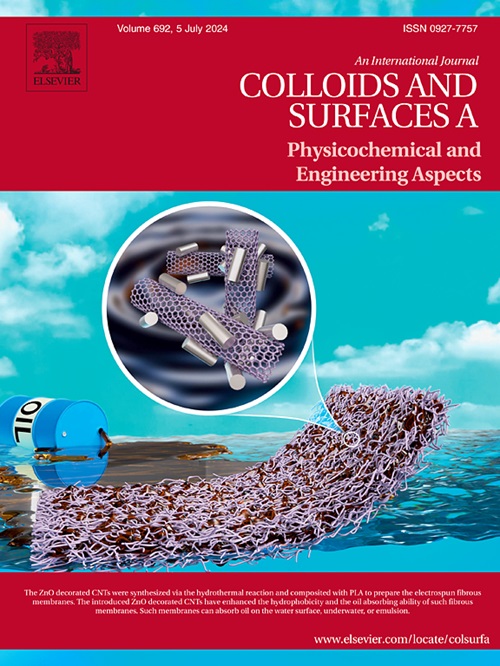通过热重法、锥量热法和垂直火焰测试了解植酸基深共晶溶剂的阻燃性
IF 5.4
2区 化学
Q2 CHEMISTRY, PHYSICAL
Colloids and Surfaces A: Physicochemical and Engineering Aspects
Pub Date : 2025-07-25
DOI:10.1016/j.colsurfa.2025.137870
引用次数: 0
摘要
植酸已成为传统卤化化合物的安全阻燃替代品,对羊毛、丝绸和棉花等天然纤维显示出强大的阻燃潜力。本研究探讨植酸型深共晶溶剂(DES)在棉织物阻燃处理中的应用。以植酸为氢键供体(HBD),氯化胆碱或乙二醇为氢键受体(HBAs)合成DES。采用浸渍法涂覆DES涂层,对其结构、表面形貌、热降解特性和阻燃性能进行了全面研究。傅里叶变换红外光谱(FTIR)和扫描电子显微镜与能量色散x射线(SEM-EDX)分析证实了DES在表面上的成功沉积,并且在处理过的表面上存在几个官能团,并鉴定出磷、碳和氮元素。锥形量热计测试证实,des涂层织物的阻燃性显著增强,峰值热释放率(pHRR)从213.4 ± 1.83 kW/m²大幅下降至50.3 ± 2.58 kW/m²。热重分析(TGA)表明,在800°C时,des涂层样品的焦渣含量从空白棉的11.8 %上升到ChCl 1:1处理织物的33.5 %。垂直火焰测试表明,DES涂层使棉织物具有自熄性能,其中ChCl 1:5涂层达到最佳效果,包括无后火,最小烟雾,减少焦炭长度为3.275 ± 0.19 cm。这些发现强调了植酸基DES作为棉织物有效和可持续阻燃剂的新用途,标志着首次全面研究证明了其显著的阻燃能力,同时减轻了纤维素纤维的酸性相关降解。本文章由计算机程序翻译,如有差异,请以英文原文为准。
Understanding flame retardancy of phytic acid-based deep eutectic solvents by thermogravimetry, cone calorimetry, and vertical flame testing
Phytic acid has emerged as a safe flame-retardant alternative to traditional halogenated compounds, showing strong flame-retardant potential for natural fibers like wool, silk and cotton. This study explores the application of deep eutectic solvents (DES) based on phytic acid for the flame-retardant treatment of cotton fabrics. DES were synthesized using phytic acid as a hydrogen bond donor (HBD) in combination with choline chloride or ethylene glycol as hydrogen bond acceptors (HBAs). The DES coating were applied via a dip-coating method, and their structure, surface morphology, thermal degradation characteristics and flame retardancy were thoroughly examined. Fourier-transform infrared (FTIR) spectroscopy and scanning electron microscopy with energy-dispersive X-ray (SEM-EDX) analysis confirmed the successful deposition of DES on the surface, with the presence of several functional groups and the identification of phosphorus, carbon, and nitrogen elements on the treated surfaces. Cone calorimeter test confirmed significant enhancement in flame retardancy for the DES-coated fabrics, with a major drop in the peak heat release rate (pHRR) from 213.4 ± 1.83 kW/m² to as low as 50.3 ± 2.58 kW/m². Thermogravimetric analysis (TGA) showed that DES-coated samples had increased thermal stability, with char residue levels rising from 11.8 % in the blank cotton to 33.5 % in the ChCl 1:1-treated fabrics at 800°C. Vertical flame testing demonstrated that the DES coatings imparted self-extinguishing properties to cotton fabrics, with the ChCl 1:5 coating achieving optimal results, including no after-flame, minimal smoke, and a reduced char length of 3.275 ± 0.19 cm. These findings highlight the novel use of phytic-acid based DES as an effective and sustainable flame-retardant for cotton fabrics marking the first comprehensive study to demonstrate their significant fire-suppressing ability while mitigating the acidity-related degradation of cellulose fibers.
求助全文
通过发布文献求助,成功后即可免费获取论文全文。
去求助
来源期刊
CiteScore
8.70
自引率
9.60%
发文量
2421
审稿时长
56 days
期刊介绍:
Colloids and Surfaces A: Physicochemical and Engineering Aspects is an international journal devoted to the science underlying applications of colloids and interfacial phenomena.
The journal aims at publishing high quality research papers featuring new materials or new insights into the role of colloid and interface science in (for example) food, energy, minerals processing, pharmaceuticals or the environment.

 求助内容:
求助内容: 应助结果提醒方式:
应助结果提醒方式:


